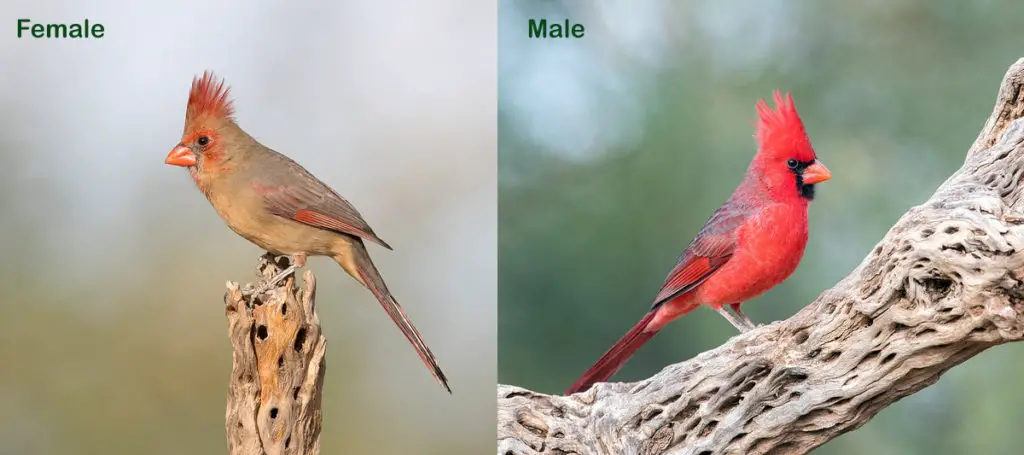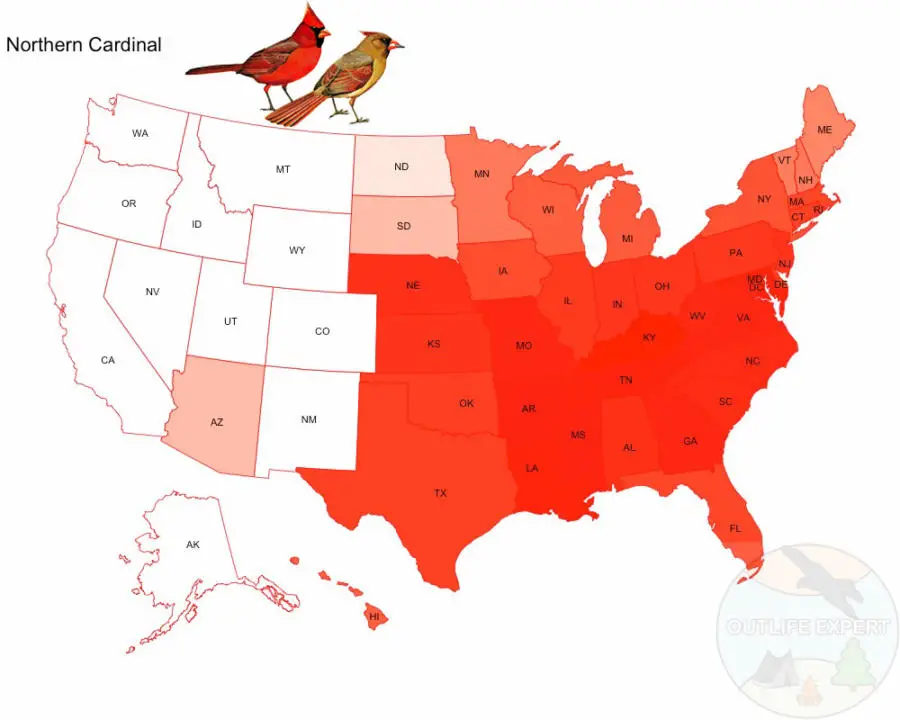Northern Cardinals are not particularly picky when it comes to their dietary preferences, however, there are limits to what size and hardness they can handle in their food.
Therefore, cardinals cannot eat whole acorns because their beak is not shaped for the purpose. Birds like woodpeckers, crows, and bluejays are stronger and have a more suitable pointy bill that allows them to crack open an acorn to eat it!
If you want to see how a blue jay handles an acorn, take a look at this video:
Cardinals much prefer softer and smaller foods such as grass seeds, berries, and insects!
What does the Northern Cardinal eat?
The Northern Cardinal diet consists mainly of seeds and fruits whereas the young receive mostly insects from their parents.
The Northern Cardinal feeds on many different seeds at bird feeders, but feeders with corn, oats, safflower, and especially sunflower seeds seem to be especially popular with the Northern Cardinal.
The preferred foods of Northern Cardinals in the wild include:
- crickets
- buckwheat
- flies
- moths
- spiders
- centipedes
- cicadas
- beetles
- grass
- butterflies
- Other seeds
- sumac
- mulberries
- hackberry
- blackberry
- wild grape
So, now that you know that about Cardinals – maybe you want to know some more about this exciting bird?

Family: Cardinalids
Origin: Southeastern US.
Diet in the wild: Insects, seeds, berries, flowers.
Feeder type preferences:
- Ground Feeder
- Large Tube feeder
- Large Hopper
- Platform feeder
Feeder food preferences:
- Black Oil Sunflower Seeds
- Hulled Sunflower Seeds
- Safflower
- Crushed peanuts
- Millet
- Milo
- Cracked Corn
Endangered: No.
The Northern Cardinal is a common and very popular backyard bird seen throughout North America. Depending on where you live, you may give the Northern Cardinal nicknames such as: the red cardinal, common cardinal, redbird, or simply cardinal. Its many names exemplify its representation of the wider cardinal family, Cardinalidae, which includes several other common birds such as the Dickcissel, some grosbeaks, and the buntings.
How and where to spot the Northern Cardinal in the US?
The Northern Cardinal is native to the Southeastern United States, where it is the official state bird of several states: West Virginia, Indiana, Virginia, Ohio, Illinois, Kentucky, and North Carolina. Furthermore, several institutions, including sports teams such as the St. Louis Cardinals and Arizona Cardinals use it as their mascot.
At the national level, the population is stable over time and the majority of observations of the Northern Cardinal have been made in the Eastern parts of the US.
Many Cardinalids are strongly colored, making them easy to spot at the bird feeder. Especially the brightly blue Indigo Bunting and the multicolored Painted Bunting are amazing examples of this colorful family.
The male Northern Cardinal is easy to recognize as it is the only bright red bird seen all year round in the Northern parts of the US.

The stronger the red color, the higher the chance that you will see the Northern Cardinal in your backyard.
The female is predominantly brown and less brightly colored which may lead to confusion with other Cardinalids, for example, its Pyrrhuloxia, Summer Tanager, or Hepatic Tanager cousins.
These cardinals, however, are more widespread in the southwestern states and northern Mexico where the Northern Cardinal is less common.
Red birds in North America
Red birds are easy to spot due to their strong colors, and most people notice them easily at bird feeders. If you live in North America and observe a flock of red birds, they are likely to be Northern cardinals! These little birds are known for their bright colors and are most often the birds people think of when asked to imagine a red bird in the US.
The Northern Cardinal is indeed the most common bright red bird in North America. But there are also other red birds in North America, such as the House Finch or the less common Purple Finch and you may even spot the (male) Summer Tanager or Scarlet Tanager (or some of the other Tanagers mentioned above) if you are lucky!
In the Eastern US, you are mostly correct in assuming the Norhern Cardinal is the most common bright red visitor!
All Cardinalids are highly vocal, and the Northern Cardinal comes across as exceptionally noisy, boasting a loud metallic voice with which it sounds the characteristic “tik-tik” call or a softer slurred whistle.
Whereas some cardinals are brightly colored throughout their entire body, the Pyrrhuloxia, which has a parrot-like bill and is considered the Southwest’s equivalent of the Northern Cardinal, is gray with crimson red patches throughout its body.
Habitat and mating of the Northern Cardinal
It prefers relatively moist habitats, such as deciduous woodlands, scrublands, desert washes, and backyards. Their breeding season is March-August where the male is particularly aggressive and repels any intruder. He is so aggressive that he will occasionally confront his own reflection in windows and various shiny surfaces.
The nest of the Northern Cardinal is somewhat flimsy with thin barks, grasses, and leaves. However, it is also “single-use” as they do not usually use the nest again in the coming year. The female lays 2-4 turquoise brown-spotted eggs per nest, an effort which it may repeat up to four times per year!




